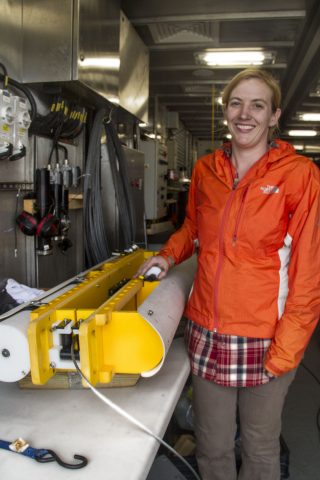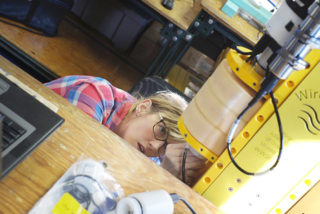
I have sailed with my share of compelling characters since I began ocean research, and perhaps it is fitting that while we study ocean color aboard the R/V Falkor, I have had the pleasure of getting to know one of the most colorful. Kirsten Carlson has joined the cruise as an artist-in-residence, bringing her zany, insightful perspectives and boundless energy to coax us from our laptops. Last night she encouraged me to try out her Artscipaedia Plankton coloring booklet. That is right – plankton – as in the microscopic organisms that color the ocean… exactly what the scientists are studying onboard. As it turns out, Kirsten has a background in marine science, and is a self-described plankton rescuer!
Colorful Shipmates
While coloring, I found my thoughts drawn back to the instrumentation I had released over the side the day before. My Wirewalker and sedimentation traps were miles away from our ship, drifting in the open ocean, collecting data and doing their thing… I hoped. I decided to draw the Wirewalker instrument array. I have spent months preparing for this cruise – testing the sensors, communications, preparing the sediment tubes, and making sure each piece of hardware is accounted for. I discovered I knew it by heart. Kirsten shared her watercolor paper and we devised a plan to collaborate – I would draw and she would paint. I can’t recall finding such catharsis on a cruise before. As the rest of our science party started a movie in our de facto hang-out space – a library/office/lounge/video conference room that has quickly become the center of orbit onboard the ship – I did my best to dust off an artistic identity I’ve rarely assumed since I was a visual art major in in high school.
Beauty in Buoys and Shackles
Drawing the mundane but critical details of each linkage in the array, I newly appreciated the elegant design of the Wirewalker: a design evolution I had observed since shortly after its invention by Dr. Rob Pinkel’s group at Scripps Institution of Oceanography. The Wirewalker is assembled in distinct segments. At the top, is a GPS-tracked buoy, and beneath this hangs a 3/16” stranded wire that stretches 150 m beneath the surface. As the buoy tugs the wire up and down over the waves, the sensor-laden Wirewalker uses a simple cam mechanism to rectify the wave action into a one-way motion down the wire. When it reaches the bottom, it hits a stop and releases it’s grip, gliding freely along the wire to the surface. This cycle is repeated every 10 minutes or so, giving us a remarkable high resolution view into the physical and physiological variations of the plankton and particles in the upper ocean.
Having a professional artist on-board (in addition to a number of talented crew and fellow scientists) has been a unique experience and has inspired me to reconnect with my inner artist. As I write this, I only hope that our collaborative art is an homage, and not an obituary to my lonely Wirewalker adrift amongst the enormous waves of the wintery North Pacific Ocean.


